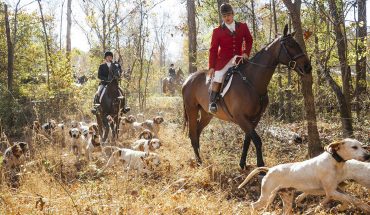Foraging for wild fungi in Raleigh
by Kaitlyn Goalen
photographs by Jillian Clark
Sam just took off running.
We’re far off the trail in the woods of Raleigh, and my guide, Sam Bradford, chef of Plates Neighborhood Kitchen, has abandoned me. He’s moving at a full gallop up a giant hill towards something that my eyes have not yet made out.
“Yes!” he screams. I stare up at him, incredulous, and begin to scale the hill (at a much slower pace).
By the time I reach him, Bradford is already thumbing through a dog-eared copy of the National Audubon Society’s mushroom guide. His pupils dance between the pages and the fallen hardwood log in front of him.
“It’s a hexagonal polypore! Oh no, actually I think it’s a spring polypore. Yes, definitely a spring polypore.”
Now his iPhone is out. I can’t help but catch a bit of his feverish excitement as he snaps photos of the fungus that’s growing all over the log. He talks quickly, pointing out some of the attributes that have helped him identify the species, and the conditions that help them flourish.
“You want to look for hardwood logs that are pretty fresh, about 2 or 3 years old,” he says. “And if the tree was hit by lightning, even better. Mushrooms love lightning.”
We’re alone in the woods, which are damp with melting snow, and quiet – but loud, if you’re listening closely, in one of those paradoxes of the natural world.
Satisfied, Bradford puts his phone away and we’re on the move again, tromping through the leaves and branches in search of…I’m not sure what, exactly.

On a stick, a row of jelly cup fungus (or, possibly, tree ears). “These are mostly accurate,” identifications, Bradford says. “With a lot of the mushrooms…every experience is a learning one.”
Spotting clues
Hunting for mushrooms is like using peripheral vision – if you look for the thing straight on, you probably won’t see it. Instead, you’re looking for indicators: a perfect storm of dead trees, spots where lightening has struck, groves of oaks near bodies of water.
Bradford has trained himself to spot these breadcrumbs. A hobbyist forager, he spends a fair amount of time in the woods, seeking oyster mushrooms, chicken of the woods, chanterelles in the summer, and of course the highly sought morels in early spring. But it’s not just about the hunt: these mushrooms are delicacies, and particularly in the case of chanterelles and morels, command top dollar at a gourmet food store (as much as $35 a pound for morels). This is a far more affordable way to enjoy the edible treasures. He has courteously let me tag along this late winter morning, even though it’s clear I’m slowing him down.
Today we’re after oyster mushrooms, which grow year-round and are favored by chefs and home cooks alike for their mild, buttery flavor. Bradford scouted these woods a few weeks earlier, but there’s been heavy snowfall since then, so we’re not sure if we’ll get lucky. Like a pointer with a scent, though, he takes long strides towards another downed tree, while I trot along like a puppy behind him.
According to Bradford, this log was covered in oyster mushrooms on his last visit – I wonder what kind of superhuman internal GPS he possesses to have found this log a second time. There are still a few hangers-on hidden on the log’s underbelly. But the rot has already set in, so we keep moving. I ask Bradford what the window is for harvesting a mushroom before it starts to rot: “just a few days,” he says.
If it all sounds a little bit like smoke and mirrors, that’s because it is. There’s no rulebook for finding mushrooms, no exactness about it. Sam explains it as an 80/20 rule. Eighty percent of the time, you’ll find mushrooms exactly where they “ought” to be, based on the conditions that they’re known to favor. But that other twenty percent is what makes mushroom foraging the biggest game of luck in the culinary world: sometimes you’ll search and search and come up empty-handed; other times you’ll hit the jackpot in a location as unlikely as the side of a road on a busy street. And of course, it’s all predicated on knowing what to look for, which in and of itself is more art than science.
And that’s just the beginning of the gray area that foraging occupies. Edible wild mushrooms grow in an impressive number of local parks and greenways in the Triangle, but it’s a no-no to forage on state property, which rules out many prime spots. And of course there’s that inconvenient fact that eating a mis-identified mushroom could lead to, among other things, death, so you’d better be sure.
Fungi jackpot
Just when I’m starting to wonder if all of this is worth it, Bradford lets out another yelp of excitement. We’re standing in front of – you guessed it – a log, but his attention is on a branch lying next to it. The white exterior of the wood is pimpled with deep, brownish-red, gelatinous ear shapes.
“Wood ear mushrooms!” he says. Immediately, I snap to attention. I’ve cooked with wood ears plenty of times, favoring them as an addition to soups and stir-fries. And now we’ve just stumbled upon them, like diamonds in the sand. Bradford continues to fawn over the branch – this is his first wood ear find – and we both snap pictures for further identification and bragging rights. Then we put the branch back where we found it (we’re in a state park, where taking mushrooms home with you is illegal) and continue on. Only now I’m hungry to find more, and I’m scanning the scene with a fevered intensity.
About five minutes later, it’s me who hollers. I beckon to Bradford, who confirms my suspicion with the pride of a coach who’s just watched his unlikeliest athlete come in first. I have found my first mushrooms: spring polypores clinging to the side of a tree. My mind is filled with fantasies of future hunts, toting home bags of chanterelles, or coming across a windfall of morels. I’m hooked.
And I’m not the only one. This same rush has led food lovers, nature lovers, and those with a passion for the chase to take up foraging. After my morning with Sam, I sit down with Chris Rumbley, director of Raleigh City Farm, who has done his own fair share of foraging.
“There’s definitely a growing interest,” he tells me. “I think people are seeking ways to reconnect with nature and there’s something primal about finding your own food. We like knowing that we can, even if we don’t have to.”
And while Rumbley occasionally buys mushrooms from foragers to sell to chefs, he notes that most of his forager friends do it only as a hobby, and keep any of the spoils of the hunt for themselves.
“It’s just too uncertain to base a business around,” he says. Those who do forage with a mind to sell are protective of their “spots,” lest they be picked over by amateurs.
“The foragers I work with are highly sensitive about conservation; they only take some of what they find, and leave some in the wild so it’ll come back next year,” he says. Bradford echoed those same sentiments, claiming a responsibility to make sure that he’s never taking more than he should.
But unlike some of the more guarded foragers out there, Bradford doesn’t see the growing interest in foraging as a danger, as long as newbies learn some of these rules of thumb. For his part, he’s generous with his time, and already has a list of friends and acquaintances who, like me, have asked to join him on an expedition.
As for me, I’m already studying up on my mushroom-identifying skills, eager for another find on the top of a hill in the woods.







